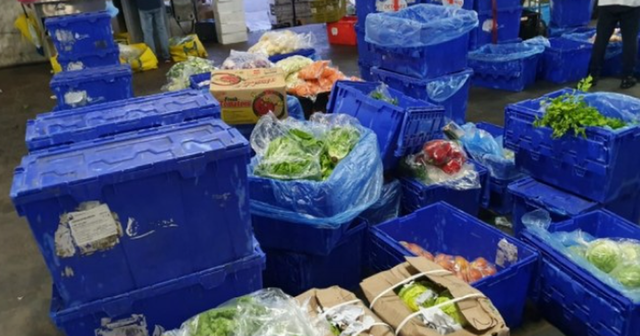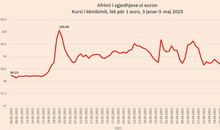
Albania, Bosnia and Montenegro with the highest dependence on food imports in Europe

Food accounts for a large share of imports in Montenegro, Bosnia, and Albania compared to other European countries, according to World Bank data for 2023. In Montenegro, food accounted for 24 percent of total imports in 2023, in Bosnia 16.3%, and in Albania 16.1%.
On the other hand, it can be seen that Serbia has the lowest share of food imports in relation to total imports with only 5.8% in 2023, followed by Slovenia with 6.2%, the Czech Republic with 6.3, the Slovak Republic with 6.5% and Turkey with 6.8%.
Montenegro and Bosnia are known for their vast areas of bush, making it impossible to grow food, while Albania has enough land to produce food for its inhabitants, but a large part of the arable land has been converted into grassland.
This high dependence on food imports makes our country more vulnerable to international crises such as wars, rising transport prices or climate change that affect global production. Our country has considerable agricultural potential, but it needs to increase investments in this sector to reduce the trade deficit.
International financial institutions recommend that in order to reduce dependence on food imports, investments are needed, especially in the modernization of agriculture through technology and infrastructure improvements. Supportive policies for domestic producers are suggested, such as subsidies, soft loans, and training for farmers to increase production and quality, and a wider diversification of the products produced.
Internal data from INSTAT shows that agriculture fell for the fourth consecutive year in 2024. Agricultural production fell by -1.1% last year from -1.8 in 2023. The agricultural sector employed 32.2 percent of the total workforce. Since 2019, agriculture's contribution to employment has declined by 4 percentage points.
More detailed data show that agriculture is on a downward trajectory, mainly due to negative developments in family farms and the sharp decline in the livestock sector. In the last decade, the number of animals for milk and meat has almost halved due to the bankruptcy of small farms.
The decline in the rural population and its aging have led to the extinction of small family farms with livestock. For the same reasons, agricultural production in the field has also declined. Family farms for self-consumption are in constant bankruptcy due to the decline and aging of the rural population.
Agricultural production is being organized in the form of businesses with greenhouses for export. Due to this transition, farmers who produced for self-consumption have now become consumers, driving the growth of imports of agricultural products from abroad./ Monitor
Latest news




The best and worst foods for a healthy liver
2025-05-05 16:41:45
Another country lifts visa requirements for Kosovo
2025-05-05 16:28:49



Judicial confrontation with OSHEE, Bardhi is declared innocent
2025-05-05 15:50:40
Bozdo: The panicked SP is preparing vote buying
2025-05-05 15:41:06
Zhupa publishes drone footage: DP will cancel the strategic investment law
2025-05-05 15:37:29

The week starts badly for 3 zodiac signs, here's what the stars predict!
2025-05-05 15:13:53
73-year-old arrested for wounding brother in Malësia e Madhe
2025-05-05 15:04:20



Jonathan Islam falls from a parachute
2025-05-05 14:36:21

Lawsuit filed against Dodik, accused of insulting Bosniaks
2025-05-05 14:12:48


Topalli denounces SP officials: They are manipulating votes in Greece and Italy
2025-05-05 13:49:25
Monika Kryemadhi appears at SPAK dressed in black
2025-05-05 13:24:47


SPAK files another charge against Ajola Xoxa, also accused of concealing income
2025-05-05 12:52:23
Sanctions and war tribunal on the agenda of EU ministers
2025-05-05 12:29:10
Rama insults and offends Bledjon Nallbatin: How can Democrats vote for a thug?
2025-05-05 12:21:41

May 5, National Martyrs' Day
2025-05-05 11:50:22

Kurti invites LDK for coalition with LVV
2025-05-05 11:37:27

Young man disappears in Tirana
2025-05-05 11:14:39

Facebook campaign: Profiles from Vietnam like "Team Edi Rama" posts
2025-05-05 10:52:24
The Special Court leaves Florenc Çapjan in prison, the testimony is revealed
2025-05-05 10:38:24
Fatal accident in Shkodra
2025-05-05 10:25:30
Gunfight in Laç/ One of the injured in serious condition
2025-05-05 10:19:06





Appears in SPAK Sali Berisha
2025-05-05 09:08:23
Përtej gallatës dhe nofkave, çfarë ofron politika për ekonominë
2025-05-05 08:52:58
A 28-year-old wanted by Spain for drug trafficking is arrested in Vau i Dejës
2025-05-05 08:42:24

Rain is back! Weather forecast for today
2025-05-05 08:20:40
Posta e mëngjesit/ Me 2 rreshta: Çfarë pati rëndësi dje në Shqipëri
2025-05-05 08:01:22

Makina përplas motorin në aksin Shkodër-Lezhë, plagosen dy adoleshentë
2025-05-04 21:29:50


Video/ The moment when the police forcibly drag away the DP candidate in Fier
2025-05-04 20:47:17
Berisha: We ask for 100 days from Albanian citizens to transform Albania
2025-05-04 20:38:25



"In the owl sleeps a vigilant fate..."/ Chris LaCivita openly criticizes Rama
2025-05-04 19:09:01
UEFA fines Real Madrid
2025-05-04 18:45:40

Habit Putin: I hope there will be no need to use nuclear weapons in Ukraine
2025-05-04 17:55:59
A 37-year-old man is found dead in the Port of Shëngjin
2025-05-04 17:32:32
Serious accident in Croatia, 2 dead and 31 injured
2025-05-04 17:17:05
Useful during the summer, here are the vitamins you should take
2025-05-04 17:03:11





Forza Italia MP calls on Albanians: Vote for democracy with Europe in mind
2025-05-04 15:18:00
Eurostat: Albanian women rank first in the region for coding programs
2025-05-04 15:01:35











Video/ Berisha is given a grand reception in Tropoja
2025-05-04 11:27:26
'Great Albania' tops the poll of the popular social media site
2025-05-04 11:08:20


Collision with truck driver, brother of candidate for deputy in Korça arrested
2025-05-04 10:04:30
Analysis of the May 11 elections: Facade campaign with little substance
2025-05-04 09:43:53
Art in mourning! Renowned actor and director Eduart Çala passes away
2025-05-04 09:13:46
Yesterday's gunfight in Laç, young man dies overnight in hospital
2025-05-04 08:54:45
Astrological forecast, May 4, 2025
2025-05-04 08:37:03

Morning Post/ In 2 lines: What mattered yesterday in Albania
2025-05-04 07:59:41



